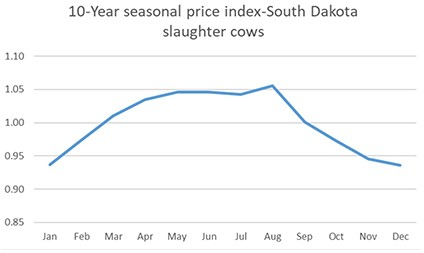By Heather Gessner
Fall weather brings many changes to the cattle operation, one of them being pregnancy testing and the subsequent removal of open, thin, lame or poor temperament cows from the herd.
Markets for Slaughter Cows
The 2018 slaughter cow market has been impacted by the large supply of beef in storage and an increase in cow slaughter volume compared to a year earlier. The South Dakota 2018 slaughter cow prices have been at or below 2017’s average monthly prices (Figure 1). The Livestock Marketing Information Center (LMIC) 2018 average through September for breaker grade cows was $65.05, 4.3 percent lower than a year earlier.
While August is historically the high for slaughter cow prices, producers can use the seasonal price index to visualize the seasonality in the slaughter cow market (Figure 2).
Using this seasonality, combined with cost of production budgets, producers can make informed decisions to increase the profit generated from cull cows.

Figure 1. Monthly average price-South Dakota breaker slaughter cows.

Figure 2. 10-year seasonal price index-South Dakota breaker slaughter cows.
Feeding Considerations
While the seasonality indicates profit, in the form of higher prices per hundred weight, may be realized by delaying sales, not every cull cow should be held and placed on feed for a later sale date. Characteristics of cows that should NOT be held include:
- Cows in a Body Condition Score (BCS) of 5 or higher. One reason to keep the cow on feed is to increase the BCS thus increasing muscle mass, the fat layer and total pounds available for sale. Cows that are already in good condition will not gain additional pounds in an efficient manner and will likely eat more in feed than the return to feeding them.
- Cows that are unsound or injured. These animals should be sold direct to a packer. Animals must be ambulatory and a direct sale reduces further injury. If a cow has been treated with any antibiotics ensure all withdrawal periods have been reached prior to any sales.
- Cows that are unhealthy. These cows offer a whole set of management challenges to the operation. Unhealthy cows may not gain efficiently and thus may not improve the profitability of the operation through feeding. However, cows that have received medication with any antibiotics need to be monitored to ensure they are not sold before withdrawal periods are reached.
Click here to see more...